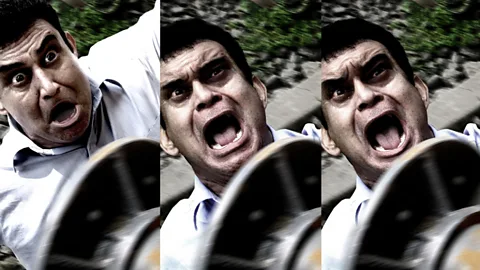What behavioural scientists are doing to improve urban living.
“Do you see the sets of traffic lights on either side?” says Anand Damani, pointing out a chaotic four-way junction from the balcony of his Mumbai apartment. Cars have stopped, blocking the pedestrian crossing. Both pedestrians and cars whose turn it is to move are stuck.
“There’s no need for two sets of signals at the same junction,” Damani points out. “Without an identical signal on the other side, drivers would stop at the right place so that they could retain a line of sight with the signal.”
Damani’s suggestion is simple, yet effective. One small change could make errant drivers do the right thing, without them even knowing it. But then he’s an expert. He is a behavioural scientist in a country where the field is yet to convince the government. “You don’t need to make people mindful to change their behaviour,” Damani says. “Subconscious nudges through the environment also work. We call this behavioural design.”
Damani started a behavioural design firm, Briefcase, back in 2013, along with his partner Mayur Tekchandaney. Their first project, Bleep, aimed to reduce Mumbai’s rampant car horn honking problem.
The method was simple: over six months, Anand and his partner offered their own cars to participants to drive for a week. The vehicles were fitted with a buzzer that would light up and go off each time the driver pressed the horn and had to be manually switched off. It also recorded honking data that was used for analysis. The result: drivers reduced their honking by an average of 61%, because the buzzer was such a nuisance.
Damani describes Bleep as a simple, practical and low-cost solution to a big urban problem: noise pollution. “If the government wants to reduce noise levels in cities, it should make Bleep mandatory in all vehicles. We even installed it in the official vehicles of the Joint Transport Commissioner of Maharashtra, but it hasn't moved further from there,” he says.
Beyond India other countries have been quicker to embrace behavioural design at government level. The UK, for instance, has a well-established, successful ‘nudge unit’, a public-private partnership called the Behavioural Insights Team. Its projects include helping persuade people to pay tax on time, increasing organ donor numbers and convincing students from low-income backgrounds to aim for top universities.
Meanwhile in the US the Obama administration created a similar unit, the Social and Behavioural Sciences Team (though it appears to have been mothballed by the Trump government). From helping people conserve electricity to suicide prevention, introducing subconscious ‘nudges’ has proved to be more efficient than the usual awareness campaigns that typically use logic to explain to people why they should or should not do something.
 Final Mile
Final MileTake public transport, in Mumbai on average between nine and 10 people die each day from train-related accidents, many involving people taking a short-cut across train tracks. In 2010, the Indian Railways approached behavioural architecture firm, Final Mile, to find a way to reduce the deaths.
Among the experiments Final Mile conducted, one in particular grabbed the spotlight for its shocking grotesquery. At Mumbai’s Wadala station, which was notorious for deaths on the track, it put up big billboards with images showing the facial expressions of a man being run over by a train. The photos (which looked alarmingly real but were staged) were arranged in three panels, amplifying the horror. The experiments, which also included painting yellow lines on sleepers to help people gauge the speed of approaching trains, succeeded deterring people from crossing the tracks. The number of deaths at the station went from 40 in the year prior to the experiment to 10 after Final Mile's measures.
“People don’t change faulty behaviour despite awareness, as humans are not rational beings. So you need new theories to change people’s behaviour,” says Biju Dominic, co-founder of Final Mile.
 Getty Images
Getty ImagesThe idea that human beings are irrational goes against classical economics, which assumes that all decision-making is based on logic. It is the premise for behavioural economics, which also incorporates psychology and cognitive neuroscience into the discipline. In 2017, American economist and creator of the “nudge theory” Richard Thaler won the Nobel Prize for Economics for his pioneering work in this new field. But is behavioural science as promising and innocuous as it seems? Could human irrationality also be exploited, not just manipulated?
Last year, Uber, the global taxi-hire service, found itself on the wrong side of nudging. As the New York Times reported, Uber used “videogame techniques, graphics and non-cash rewards to prod drivers into working longer and harder”, arguably to the company’s gain. For instance, Uber preloaded the next journey before the current one had ended, enticing drivers to continue working without a break. Some local Uber managers adopted female personas online so that the largely male driver workforce might be more inclined to their suggestions. Finally, when drivers logged out for the day, the app would encourage them to keep working, citing arbitrary targets such as beating the previous day’s earnings, the paper reported.
“Nudges and other uses of behavioural science to change behaviour are supposed to be used in the best interest of the people whose behaviour the nudges are trying to change,” says Francesca Gino, a behavioural scientist and professor at the Harvard Business School.
Dominic of Final Mile seems to agree with her. Initially, his company helped brands like Unilever market more successfully using behavioural science. “But soon enough, we realised that this science had more width than just helping to sell soap. We eventually moved out of marketing into tackling social problems like open defecation and garbage disposal,” he adds.
 Getty Images
Getty ImagesFinal Mile has been approached once again by the Indian government – this time to use behavioural science to prevent speeding on the Mumbai-Pune Expressway. In the past, the firm successfully reduced speeding by 50% on the National Highway 44 between Hyderabad and Bengaluru. Then, Dominic’s team painted sets of parallel white lines that ran across the road. The space between these lines narrowed as a driver approached an accident-prone zone. The driver, fooled into thinking that the vehicle was accelerating, involuntarily reached for the brake.
According to Dominic, nudges could also be as simple as a change of name. “When you call it the Mumbai-Pune ‘Expressway’, it gives people the impression that the road is meant to be sped on.”
--
To comment on this story or anything else you have seen on BBC Capital, please head over to our Facebook page or message us on Twitter.
If you liked this story, sign up for the weekly bbc.com features newsletter called "If You Only Read 6 Things This Week". A handpicked selection of stories from BBC Future, Culture, Capital and Travel, delivered to your inbox every Friday.


Post a Comment